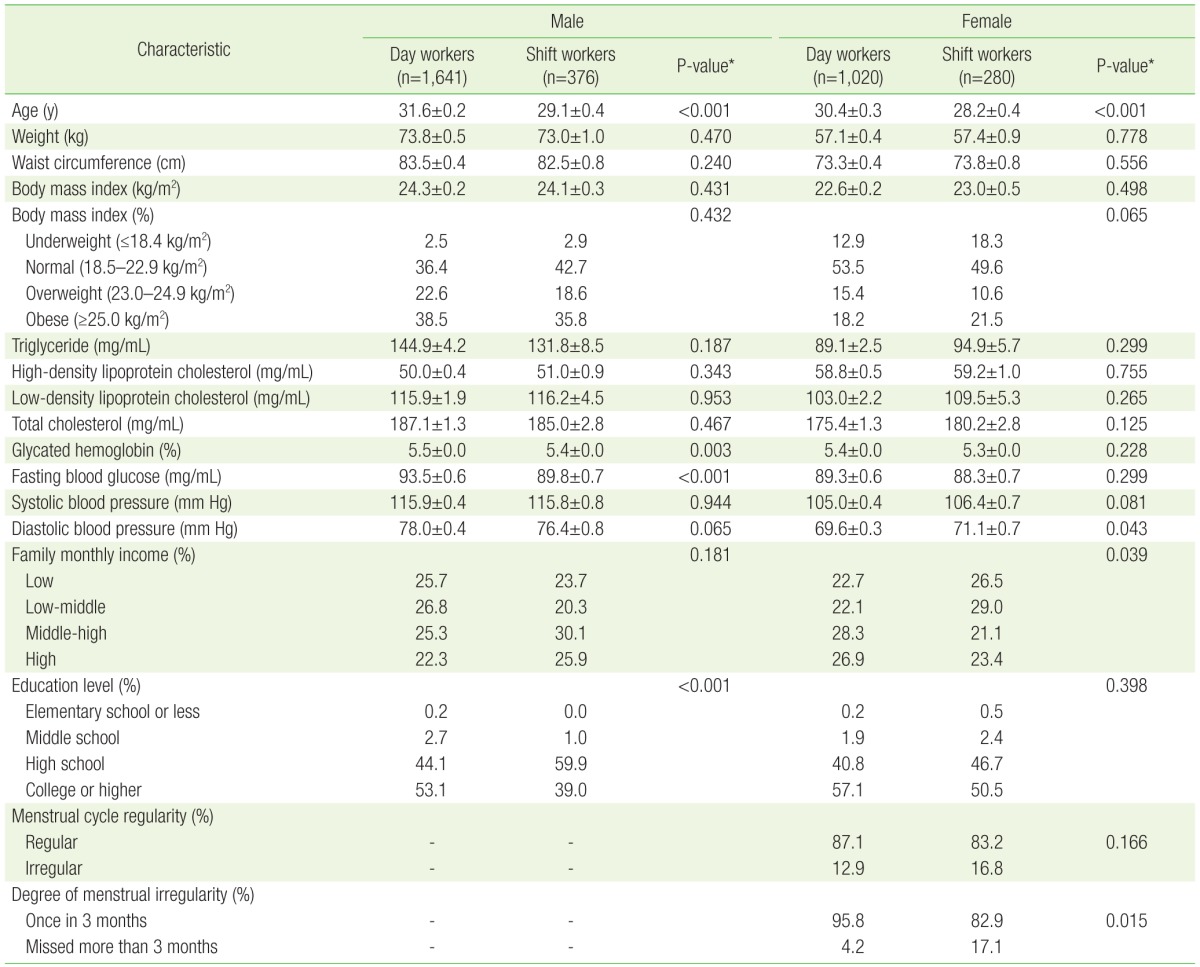1. Hedstrom AK, Akerstedt T, Olsson T, Alfredsson L. Shift work influences multiple sclerosis risk. Mult Scler 2015;21:1195-1199. PMID:
25698167.


2. Kim C, Cho Y. Working conditions and leisure-time physical activity among waged workers in South Korea: a cross-sectional study. J Occup Health 2015;57:259-267. PMID:
25752656.


4. Lim S, Shin H, Song JH, Kwak SH, Kang SM, Yoon JW, et al. Increasing prevalence of metabolic syndrome in Korea: the Korean National Health and Nutrition Examination Survey for 1998-2007. Diabetes Care 2011;34:1323-1328. PMID:
21505206.



5. Expert Panel on Detection, Evaluation, and Treatment of High Blood Cholesterol in Adults. Executive summary of the third report of the National Cholesterol Education Program (NCEP) Expert Panel on Detection, Evaluation, and Treatment of High Blood Cholesterol in Adults (Adult Treatment Panel III). JAMA 2001;285:2486-2497. PMID:
11368702.


6. Frost P, Kolstad HA, Bonde JP. Shift work and the risk of ischemic heart disease: a systematic review of the epidemiologic evidence. Scand J Work Environ Health 2009;35:163-179. PMID:
19387517.


8. Lee JH, Um MH, Park YK. The association of metabolic syndrome and serum γ-glutamyl transpeptidase: a 4-year cohort study of 3,698 Korean male workers. Clin Nutr Res 2013;2:67-75. PMID:
23429457.



9. Ohlander J, Keskin MC, Stork J, Radon K. Shift work and hypertension: prevalence and analysis of disease pathways in a German car manufacturing company. Am J Ind Med 2015;58:549-560. PMID:
25773725.


10. Taniyama Y, Nakamura A, Yamauchi T, Takeuchi S, Kuroda Y. Shift-work disorder and sleep-related environmental factors in the manufacturing industry. J UOEH 2015;37:1-10. PMID:
25787096.


11. Rajaratnam SM, Howard ME, Grunstein RR. Sleep loss and circadian disruption in shift work: health burden and management. Med J Aust 2013;199:S11-S15.

12. Boivin DB, Boudreau P. Impacts of shift work on sleep and circadian rhythms. Pathol Biol (Paris) 2014;62:292-301. PMID:
25246026.


13. Canuto R, Garcez AS, Olinto MT. Metabolic syndrome and shift work: a systematic review. Sleep Med Rev 2013;17:425-431. PMID:
23531362.


14. Shim JY. The metabolic syndrome prevention and treatment for Korean adults. Korean J Fam Pract 2015;5:375-420.
16. Sookoian S, Gemma C, Fernandez Gianotti T, Burgueno A, Alvarez A, Gonzalez CD, et al. Effects of rotating shift work on biomarkers of metabolic syndrome and inflammation. J Intern Med 2007;261:285-292. PMID:
17305651.


17. Guo Y, Rong Y, Huang X, Lai H, Luo X, Zhang Z, et al. Shift work and the relationship with metabolic syndrome in Chinese aged workers. PLoS One 2015;10:e0120632PMID:
25761114.



18. De Bacquer D, Van Risseghem M, Clays E, Kittel F, De Backer G, Braeckman L. Rotating shift work and the metabolic syndrome: a prospective study. Int J Epidemiol 2009;38:848-854. PMID:
19129266.



19. Pietroiusti A, Neri A, Somma G, Coppeta L, Iavicoli I, Bergamaschi A, et al. Incidence of metabolic syndrome among night-shift healthcare workers. Occup Environ Med 2010;67:54-57. PMID:
19737731.


20. Pan A, Schernhammer ES, Sun Q, Hu FB. Rotating night shift work and risk of type 2 diabetes: two prospective cohort studies in women. PLoS Med 2011;8:e1001141PMID:
22162955.



21. Maury E, Ramsey KM, Bass J. Circadian rhythms and metabolic syndrome: from experimental genetics to human disease. Circ Res 2010;106:447-462. PMID:
20167942.



22. Leproult R, Holmback U, van Cauter E. Circadian misalignment augments markers of insulin resistance and inflammation, independently of sleep loss. Diabetes 2014;63:1860-1869. PMID:
24458353.



23. Park MJ, Yun KE, Lee GE, Cho HJ, Park HS. A cross-sectional study of socioeconomic status and the metabolic syndrome in Korean adults. Ann Epidemiol 2007;17:320-326. PMID:
17300958.


24. Zuo H, Shi Z, Hu X, Wu M, Guo Z, Hussain A. Prevalence of metabolic syndrome and factors associated with its components in Chinese adults. Metabolism 2009;58:1102-1108. PMID:
19481771.


25. Solomon CG, Hu FB, Dunaif A, Rich-Edwards JE, Stampfer MJ, Willett WC, et al. Menstrual cycle irregularity and risk for future cardiovascular disease. J Clin Endocrinol Metab 2002;87:2013-2017. PMID:
11994334.


26. Peplonska B, Bukowska A, Sobala W. Association of rotating night shift work with BMI and abdominal obesity among nurses and midwives. PLoS One 2015;10:e0133761PMID:
26196859.



28. Jayasena CN, Franks S. The management of patients with polycystic ovary syndrome. Nat Rev Endocrinol 2014;10:624-636. PMID:
25022814.



29. Joham AE, Boyle JA, Zoungas S, Teede HJ. Hypertension in reproductive-aged women with polycystic ovary syndrome and association with obesity. Am J Hypertens 2015;28:847-851. PMID:
25542625.



30. Kim JJ, Choi YM. Dyslipidemia in women with polycystic ovary syndrome. Obstet Gynecol Sci 2013;56:137-142. PMID:
24327994.



31. Palomba S, Falbo A, Russo T, Rivoli L, Orio M, Cosco AG, et al. The risk of a persistent glucose metabolism impairment after gestational diabetes mellitus is increased in patients with polycystic ovary syndrome. Diabetes Care 2012;35:861-867. PMID:
22338097.














